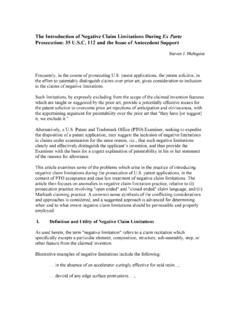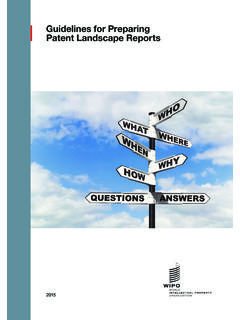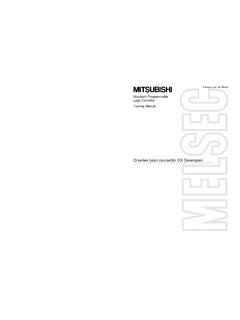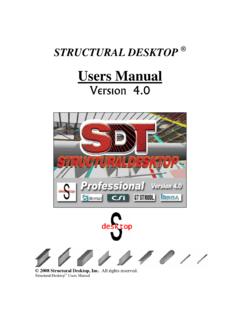Transcription of MANUAL OF PATENT OFFICE
1 MANUAL OF PATENT OFFICE PRACTICE AND PROCEDURE Version As modified on March 22, 2011 PUBLISHED BY: THE OFFICE OF CONTROLLER GENERAL OF PATENTS, DESIGNS & TRADEMARKS BOUDHIK SAMPADA BHAWAN, S. M. ROAD, ANTOP HILL, MUMBAI (INDIA) Preface The Patents Act, 1970 was amended in 1999, 2002 & 2005. The amended Act, in accordance with TRIPS, has provided for product patents in foods, medicines and chemical substances. India became signatory to PCT in 1998. As a consequence, PATENT filing including PCT National Phase Applications have increased exponentially. Considerable changes have been made in the patenting procedure through the introduction of Patents Rules, 2003, which were further amended in 2005 and 2006, resulting in new practices and procedure.
2 Indian PATENT OFFICE has been modernized with OFFICE automation and electronic processing of PATENT applications during the past one decade. The objective of the modernization project was to increase the efficiency and streamline the functioning in tune with the international scenario, especially with regard to transparency. It has been ou2r constant endeavor to be more transparent in all the spheres of patenting process. IT enabled OFFICE process have enabled us to make all information relating to the status of PATENT application and contents of file, publicly available through the official website. This MANUAL is yet another step to fulfill our commitment to be more efficient and transparent. There has been a demand from the new inventors, PATENT practitioners and foreign applicants to codify the practices in Indian PATENT OFFICE in the form of a MANUAL .
3 A draft MANUAL was published in 2009 in the official website inviting comments and suggestions from stakeholders. Taking into account the comments and suggestions received, that draft has been thoroughly revised to make it more precise and simple. It is our ardent hope that this MANUAL will effectively meet the demands from stakeholders. This MANUAL may be considered as a practical guide for effective prosecution of PATENT applications in India. However, it does not constitute rule making and hence, does not have the force and effect of law. The MANUAL will be revised from time to time based on interpretations by a Court of Law, statutory amendments and valuable inputs from the stakeholders. (P H Kurian) Controller General of Patents, Designs and Trademarks INDEX Chapters: Page No.
4 01 Introduction 1 02 Key definitions 3 03 Filing of PATENT Application 7 04 Publication of application 27 05 Provisional and complete specification 30 06 Divisional application and PATENT of addition 47 07 Convention application, international application and 51 national phase application 08 Examination and grant 75 09 Post-grant opposition 109 10 Post-grant procedures 113 11 Appeals 124 12 Revocation of PATENT 127 13 Compulsory licensing 130 14 Use of PATENT for purposes of Government 140 15 PATENT agents 147 16 Offences and penalties 151 17 General powers of Controller 153 18 General services 160 19 Scientific advisors 164 20 Miscellaneous provisions 167 21 Time limits 170 1 Chapter 1 Introduction 1. This MANUAL has been compiled with an intention to codify the practices and procedures being followed by the Indian PATENT OFFICE and is intended to serve as a procedural guide for the practitioners and other users of the Indian PATENT System.
5 2. Indian PATENT OFFICE works from four locations viz. Delhi, Mumbai, Kolkata and Chennai with defined areas of territorial jurisdiction. Introduction of OFFICE automation and electronic processing of PATENT applications has resulted in a certain level of uniformity and transparency. Maximum amount of information has been made available to the public viz. information relating to PATENT applications, including the status, examination reports and other documents. This MANUAL is expected to bring in further transparency and uniform practices in the four offices. 3. Processing of a PATENT application is a multi-stage process, involving filing of an application, electronic data processing, screening and classification, publication, examination, pre-grant opposition, grant / refusal.
6 Different persons like Examiner of Patents, Controller of Patents, Applicant / Agent and general public are involved in the process. Rights, functions and responsibilities of all stakeholders have been explained to ensure smooth functioning of the PATENT System. 4. This MANUAL is expected to spell out PATENT OFFICE practices and procedure and bridge any information gap that currently exists in this regard. It is not intended to be an interpretation of the Indian PATENT Law. 5. The procedure of filing of a PATENT application and its processing up to grant / refusal, maintenance etc. is explained in the following chapters. This MANUAL does not cover the infringement proceedings. Certain matters like exceptions to the rights of patentee, Government use, Compulsory Licensing etc.
7 Have also been included. 6. Some of the key definitions have been explained in Chapter-2. 2 7. Chapters 3 to 7 deal with the procedure of filing a PATENT application, including Ordinary Application, PCT International Application, PCT National Phase Application, Convention Application, Application for PATENT of Addition & Divisional Application. 8. Chapters 8 & 9 relate to examination, grant, pre-grant and post grant oppositions. 9. Chapters 10 to 14 cover the post-grant procedures such as maintenance of PATENT , appeal, revocation, compulsory licensing and use of patents for the purposes of Government. 10. Chapters 15 to 20 relate to PATENT Agents, offences and penalties, general powers of Controller, general services, scientific advisors and miscellaneous provisions.
8 11. Time limits prescribed under the Act and Rules have been specifically dealt with separately in Chapter 21. 12. The Officers functioning under the Act have been vested with statutory powers. They also have some discretionary powers under the Act, which are to be exercised judiciously. As regards the patentability of any subject matter under consideration by an Officer empowered under the Act, he shall not be guided solely by the contents of this MANUAL but shall take judicious decisions based on the Act, Rules and any judicial decisions on the matter. However, all officers of PATENT OFFICE shall follow the procedure set forth in the MANUAL . 3 Chapter 2 Key definitions General For better appreciation of this MANUAL , the user may require to have clearx understanding of certain terms which are defined in the Act or Rules.
9 Some of the important definitions are as under. Definitions "Controller" means the Controller General of Patents, Designs and Trade Marks referred to in Section 73. Controller shall be construed as including a reference to any officer discharging the functions of Controller in pursuance of Section 73. The OFFICE of Controller General of Patents, Designs and Trademarks is at Mumbai. The Controller General of Patents, Designs and Trademarks is appointed by the Government of India under Section 3 of the Trademarks Act, 1999. The person so appointed will be the Controller of Patents for the purposes of Patents Act, 1970. The Central Government may also appoint other officers who shall discharge, under the superintendence and directions of the Controller General of Patents, Designs and Trademarks, such functions of the Controller under this Act as he may authorize in writing, from time to time Section 2(1)(b), 2(2)(a), 73 Section 3 of Trademarks Act, 1999 4 by general or special order.
10 The Controller General has authorized the Assistant Controllers, Deputy Controllers, Joint Controllers and Senior Joint Controllers to discharge most of the functions under the Act. The Controller General has the power to withdraw any matter pending before an officer, by an order in writing and for reasons to be recorded therein, and deal with such matter himself either de novo or from the stage it was so withdrawn or transfer the same to another officer who may subject to special directions in the order of transfer, proceed with the matter either de novo or from the stage it was so transferred. "Government undertaking" means any industrial undertaking carried on a. by a department of the Government, or b.

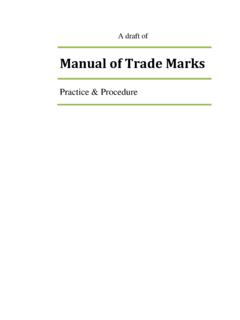

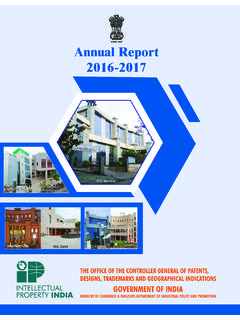





![SECTION 3, SUB SECTION (i)] MINISTRY OF …](/cache/preview/4/c/a/9/2/e/2/c/thumb-4ca92e2c965668654b86eb34a7d11e99.jpg)


